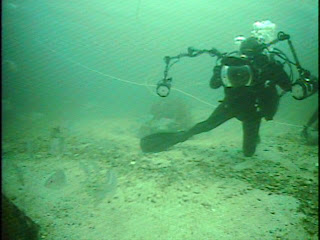Last Sunday I decided to stroll over to the pier for the Outcast Mega Shark Tournament weigh-in to see what I could see. Let me tell you, when Pensacola hosts a shark tournament, they throw a shark festival. I walked up to rock climbing walls, water slides, and carnival games. It was a kid’s dream: fumble around in the moon bounce, play in the water fountains, dive into a blue snow cone, and take a peek at the toothy giants that rise up on massive hooks.

Shark tournaments are a little different from inshore fishing slams or offshore championships. There seemed to be a lot of downtime in between the rare moments of excitement of the sharks’ arrival (that may explain the diversions). But when the animals are crane lifted out of the boats and up into the air, the crowds and cameras ignite. The sharks are placed on the weigh hook next to the leader board, the mic man interviews the fishermen, and then the crowd shouts out guesses on the weight of the shark to try to win prizes.

The sharks were weighed and placed in an ice filled bin next to a research tent. I went over to the tent to say hi to a friend, and she let me poke my nose into their work. Whew, to describe the smell…refer to
that’s the smell of desire, my lady. They were taking tissue samples, gonads, liver samples, vertebrae, and stomachs. One of the stomachs of a bull shark was spilled out onto a tarp for observation. After a little searching I found some fish otoliths, stingray spines, and some skull pieces. It looked like the bull shark had fed on some hardhead catfish, numerous stingray, and judging from the shape of one set of the otoliths, a red snapper. Sorry the next couple of pictures are a little "wet". Try not to read the blog at lunch. Otoliths are structures in the fishes' head that fisheries biologists use to identify and age the fish (like counting rings on a tree), as well as function as a natural tag of the fish.

The roundish white things are fish otoliths.
To catch this particular shark, the fishermen used a cownose ray. It’s a popular shark fishing tactic to snatch hook a ray, cut its wings off, thread a hook through it, and then throw it out as a struggling, yet stationary live bait.

After the samples were taken, the carcasses were then thrown into a refrigerated trailer to be taken to the nearby zoo to feed the animals.

The leader board showed a 400 pound hammerhead that eventually turned out to be the overall winner. The usual suspects had been caught: bull, tiger, nurse, hammerhead and mako sharks. Most of the sharks that were caught weighed between 100 and 200 pounds: babies, youngsters, and teenagers. Most of the sharks caught and weighed at these tournaments are immature and have never reproduced.

Sharks are long-lived and late to mature, and these kill tournaments take a range of sizes, therefore ages of targeted shark species. I could explain as to why sharks are incredibly important to marine ecosystems, but David over at Southern fried science has done just that in his article, Four things everyone needs to know about sharks. It’s good, give it a read.

There are many sport fish tournaments that operate on a completely no-kill basis. Tarpon and Billfish tournaments are a great example of this. Fish are caught, tagged, and video captured. This allows the fishermen to compete while the animals get to swim away. Of course, if the shark tournaments operated this way, people would complain that the weigh-in would be a wash. Next year, let’s get a Ferris wheel, some smoked turkey legs, and friggin' fire eater. You want to kill something that ecologically important just to hang it on a hook, take a few pictures, get some “oohs and ahhs”, and then give it to the flies? I ask, why not a no-kill shark tournament?
Recently, Fort Myers Beach, Florida has made the switch with their tournament this year.
Link. Hopefully, more and more venues will follow this example.
Instead of a festival celebrating man versus beast with dripping carcasses hanging from hooks…how about a victory party with live music, a fishing seminar for children, and a boat show? We could even throw in a mechanical shark that people can ride.
Let’s face it. It’s a lot better than what kill tournaments could become, and nobody likes carnies.


























